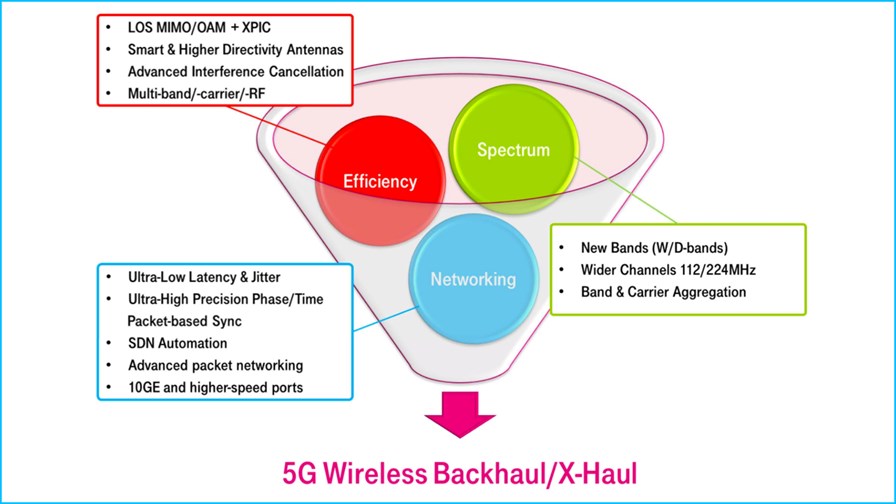
© ETSI
- Future use of high frequency mobile for 5G backhaul
- ETSI investigates microwave and mmWave for 5G
- Highlights the importance of suitable regulation and licensing
- Industry needs to simplify 5G wireless backhaul and X-Haul deployments
ETSI’s industry specification groups continue to publish technical reports and guidelines, the importance of which is often overlooked in the excitement surrounding open source software and open hardware. The latest release comes from the mWT ISG – the mmWave transmission group – which has addressed the upcoming and important 5G backhaul/X-Haul scenarios. It looks at how the evolution of current microwave and mmWave technologies will support upcoming 5G access requirements. The ultra-dense radio access networks described by 5G will be built to increase end customers’ Quality of Experience by setting the 5G area traffic capacity target at 10Mbit/s per m2. Hence a new small-cell backhaul network is expected to grow massively over the next few years.
X-Haul is a fairly recent term used to describe the evolved transport interface resulting from different RAN split options. It is expected that next-generation backhaul applications will be more relevant within a mid/long-term time horizon, from around 2020 and beyond. Topics related to regulation and licensing are discussed in the document. It calls for more backhaul spectrum and bandwidth, band and carrier aggregation, plus features such as advanced interference cancellation techniques, higher directivity and smart antennas solutions, as well as SDN automation. It believes there is a necessity for more backhaul spectrum, including new frequency bands such as W-band, D-band, other mmW/microwave bands, plus wider channels for microwave bands.
The report also highlights the importance of appropriate regulation and licensing to ease 5G wireless backhaul and X-Haul deployments. It advises that authorities apply regulatory policies and costs in-line with the use cases' requirements. The evolution of wireless technologies is leading to higher spectral efficiency and higher frequency re-use, so respective licensing needs to facilitate and motivate this usage.
ETSI believes it is of “paramount importance” to prepare the way for new backhaul or X-Haul architectures for 5G. To this end, various technology, regulation and standardisation efforts are in currently in progress. You can read more by downloading the freely available report.
Original Press Release:
ETSI publishes Report on 5G Wireless Backhaul/X-Haul
Sophia Antipolis, 11 December 2018
Using Microwave and Millimetre-wave for 5G
ETSI’s millimetre Wave Transmission Industry Specification Group (mWT ISG) has just released a new Report, ETSI GR mWT 012, which addresses the prominent 5G backhaul/X-Haul scenarios. It also presents how current microwave and millimetre wave transmission technologies, as well as their foreseen evolution in the pertinent areas of innovation, will satisfy upcoming 5G access requirements. The Report points out the importance of the appropriate regulation and licensing to ease 5G wireless backhaul/X-Haul deployments.
Mobile communication technology is evolving rapidly towards its 5G deployment phase, which aims to develop new business opportunities related to enhanced Mobile Broadband, Ultra-Reliable and Low Latency Communications and massive Machine-Type Communications. New radio access network architecture trends, aiming at higher network efficiency and improved service delivery, are also discussed within the scope of 5G. In parallel, it is expected that 5G deployments will be characterized by increased network density, mainly driven by small cell implementation. As with the previous 3GPP generations, it is predicted that service providers will start with an early stage of deployment and they will progressively move towards long-term maturity, hence mobile access sites are going to be gradually upgraded to 5G configurations that will appear in different flavours and iterations of standards.
It is of paramount importance to prepare the ground for the new backhaul/X-Haul architecture for 5G. To this end, various developments in the domains of technology, regulation and standardization are in progress. In reality, the microwave and millimetre wave transmission technologies satisfy the 5G "Early Stage" requirements and under a forward-looking view, innovations on wireless backhaul/X-haul technologies will continue towards 5G, focusing on capacity, latency, spectral efficiency, higher transmission distances, synchronization and networking functionalities, so as to address the 5G "Mature Stage" requirements that will appear later.
GR mWT 012 shows that microwave and millimetre wave transmission technologies are going to continue to play a pivotal role in the 5G era as they will be fundamental pillars of service providers' network development strategy to address the future radio access demands. This view is also strengthened due to the inherent benefits of wireless backhaul/X-Haul with regard to performance, ease of deployment, fast time-to-market and cost efficiency.
Email Newsletters
Sign up to receive TelecomTV's top news and videos, plus exclusive subscriber-only content direct to your inbox.




